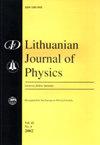用于生物组织大样本区域快速成像的宽视场二次谐波生成显微镜优化
IF 0.3
4区 物理与天体物理
Q4 PHYSICS, MULTIDISCIPLINARY
引用次数: 2
摘要
二次谐波生成(SHG)显微镜是一种无标记成像方法,可用于可视化生物组织中胶原结构的详细排列。在这里,我们试图优化宏观固定组织样本区域的显微SHG图像采集速度,采用高功率和1 MHz脉冲重复频率激光的宽视场成像,结合机械样本扫描。与传统的激光扫描显微镜不同,最佳的宽视场采集需要照明区域的大小和产生的信号强度之间的相互作用。我们描述了设置图像参数的定量程序,以获得最大的平铺图像采集速度,并描述了可能的激光参数优化,以进一步提高采集速度。本文章由计算机程序翻译,如有差异,请以英文原文为准。
Optimization of wide-field second-harmonic generation microscopy for fast imaging of large sample areas in biological tissues
Second-harmonic generation (SHG) microscopy is a label-free imaging method that can be used to visualize the detailed arrangement of collagen structures in biological tissues. Here, we sought to optimize the speed of microscopic SHG image acquisition of macroscopic fixed tissue sample areas by employing the wide-field imaging with a high power and medium, 1 MHz pulse repetition frequency laser in combination with a mechanical sample scanning. Unlike in the conventional laser-scanning microscopy, the optimum of the wide-field acquisition entails an interplay between the size of the illuminated area and the intensity of the generated signal. We delineate quantitative procedures to set the image parameters for the maximum speed of the tiled image acquisition, and also describe the possible optimization of the laser parameters for further enhancement of the speed of acquisition.
求助全文
通过发布文献求助,成功后即可免费获取论文全文。
去求助
来源期刊

Lithuanian Journal of Physics
物理-物理:综合
CiteScore
0.90
自引率
16.70%
发文量
21
审稿时长
>12 weeks
期刊介绍:
The main aim of the Lithuanian Journal of Physics is to reflect the most recent advances in various fields of theoretical, experimental, and applied physics, including: mathematical and computational physics; subatomic physics; atoms and molecules; chemical physics; electrodynamics and wave processes; nonlinear and coherent optics; spectroscopy.
 求助内容:
求助内容: 应助结果提醒方式:
应助结果提醒方式:


